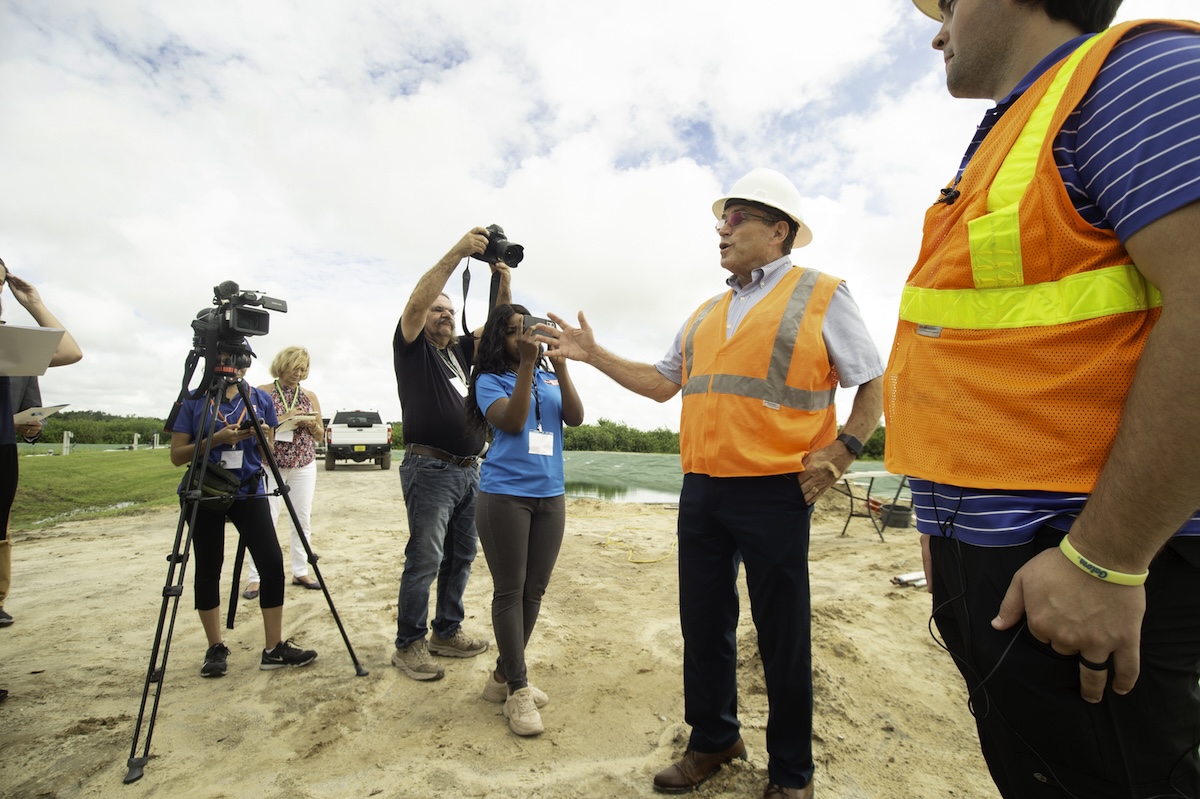Polk County had a $2.5 million problem at its landfill.
At issue was the cost and treatment of leachate (LEE-chayt) – the liquid that filters to the bottom of the landfill at tens of thousands of gallons per day. Polk County officials have been hauling it to a treatment facility offsite for $2.5 million a year because they were not able to treat it onsite.
It is a common practice for solid waste departments. As landfills grow, the volume of leachate increases; many Florida counties are seeking cost effective and sustainable ways to treat their leachate.
In Polk County, University of Florida researchers have solved the problem.
A team from UF’s Engineering School of Sustainable Infrastructure and Environment with the Herbert Wertheim College of Engineering designed a complex and sustainable wetlands-filtration system that could serve as a model for other counties.
“Our wetlands-treatment system is designed to reduce or completely eliminate the county’s dependency on third-party transporters and treatment services,” said Dale Henderson, director of Polk County Solid Waste. “We have a tremendous partnership with the University of Florida and are extremely proud of this facility.”
Henderson spoke on Sept. 10 during a media event at the Polk County landfill to introduce UF’s new leachate-wetlands treatment facility and a new on-site renewable natural gas plant that turns landfill gas (methane) into energy to sell.
County officials touted these new sustainable initiatives amid news that it would discontinue curbside recycling for residents in the unincorporated Polk County. Polk is not alone in discontinuing its curbside program; vast market fluctuations in recycled materials have forced municipalities to re-evaluate.
Thus, the county tempered the curbside news last week with the introduction of the new green initiatives at the landfill.
In 2019, Polk County officials asked UF researchers to explore more sustainable leachate management practices. Led by UF engineering professors Tim Townsend, Ph.D., and Steven Laux, and Ph.D. student Dreyton Lott, UF researchers developed a wetlands-based system to treat landfill leachate.
“Leachate contains ammonia nitrogen that can be treated effectively using constructed wetlands, a low energy alternative that uses natural systems to treat leachate,” Laux. noted.

UF professor Steven Laux speaks to the media about the leachate treatment facility UF designed during a tour of the facility Tuesday, Sept. 10, at the Polk County landfill.
The UF-designed Constructed Wetlands Leachate Treatment System, or CWLTS, is scheduled to go online Oct. 11. Funded by Polk County, the $11 million CWLTS is expected to pay for itself in leachate-transport fees in five years, according to county officials.
Leachate is formed when rainwater and other sources of moisture percolate through the landfill, bringing nitrogen in the form of ammonia, salts and trace amounts of metals into the waste. Untreated leachate can contaminate groundwater, but modern landfills collect leachate using a bottom-liner system.
UF evaluated the effectiveness of the concept at a pilot scale, and the results were promising, county officials said. Treating up to 46,000 gallons a day of leachate, CWLTS utilizes pretreatment aeration and sedimentation ponds, engineered treatment wetland units, a free-water surface wetland cell, a mixing basin and a zero-discharge industrial wastewater pond. All treatment units before the zero-discharge industrial wastewater pond have a synthetic bottom lining to control discharge of untreated leachate to the environment.
“Currently, Polk County collects its leachate in two large tanks. All the leachate is pumped there and transported offsite to a wastewater plant,” Lott said during the media tour. “With this system, the leachate will be pumped here and treated. There is less reliance on third parties controlling price.”
The process:
“The CWLTS mimics wetlands, utilizing a natural process to break down chemicals on site to meet ground water standards,” Polk County noted in a fact sheet.
There are similar facilities like this throughout the country, Lott said. Laux noted CWLTS is on acres of land formerly used as a phosphate mine, so the space and topography also make this system unique.
“The technology is proven but still kind of rare within the country. So pursuing something like this and furthering the solid waste industry and working with Polk County, is very valuable,” Lott said.
UF has worked with Polk County for years, particularly with civil engineering projects.
"I cannot overstate the value of that partnership,” Henderson said at the media event. “We are extremely proud and excited about this facility, how UF is assisting the county with construction, startup and downstream management.”